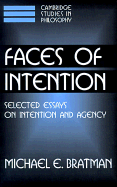Book contents
- Frontmatter
- Contents
- Acknowledgments
- 1 Introduction: Planning Agents in a Social World
- PART ONE ACCEPTANCE AND STABILITY
- PART TWO SHARED AGENCY
- PART THREE RESPONSIBILITY AND IDENTIFICATION
- PART FOUR CRITICAL STUDIES
- 11 Davidson's Theory of Intention
- 12 Castañeda's Theory of Thought and Action
- 13 Cognitivism about Practical Reason
- 14 Review of Korsgaard's The Sources of Normativity
- Index
11 - Davidson's Theory of Intention
Published online by Cambridge University Press: 18 December 2009
- Frontmatter
- Contents
- Acknowledgments
- 1 Introduction: Planning Agents in a Social World
- PART ONE ACCEPTANCE AND STABILITY
- PART TWO SHARED AGENCY
- PART THREE RESPONSIBILITY AND IDENTIFICATION
- PART FOUR CRITICAL STUDIES
- 11 Davidson's Theory of Intention
- 12 Castañeda's Theory of Thought and Action
- 13 Cognitivism about Practical Reason
- 14 Review of Korsgaard's The Sources of Normativity
- Index
Summary
In an important and fascinating series of papers, spanning a decade and a half, Donald Davidson has sketched a general theory of intention, a theory that tries to explain what it is to do something intentionally, what it is to intend to do something later, and how these two phenomena are related. In this paper I say what this theory is, argue that it faces a pair of serious difficulties, and diagnose these difficulties as rooted in an overly limited conception of the role of intentions and plans in practical reasoning.
DAVIDSON'S THEORY: MAIN IDEAS
Davidson begins with intentional action. In his classic paper ‘Actions, Reasons and Causes’, he sketches the following general view. Intentional action is action that is explainable, in the appropriate way, by appeal to the agent's reasons for action. The reasons that explain intentional actions are appropriate pairs of the agent's desires (and other ‘pro-attitudes’) and beliefs. When one acts for a, certain reason an appropriate desire–belief pair causes one's action. Suppose, for example, that I intentionally go to Davies Hall because I want to hear Pavarotti sing and believe going to Davies Hall would be a way of doing this. Since I act for this reason, the pro-attitude and belief cause my action.
This conception of intentional action makes no essential appeal to any distinct state or event of intending to go to Davies Hall that intervenes between my desire–belief pair and my action.
- Type
- Chapter
- Information
- Faces of IntentionSelected Essays on Intention and Agency, pp. 209 - 224Publisher: Cambridge University PressPrint publication year: 1999
- 9
- Cited by



